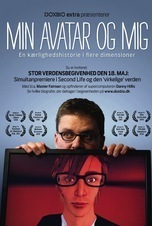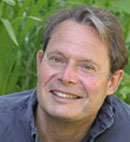Stewart Brand's Blog, page 100
July 7, 2011
My Avatar and Me
When it comes to Danish meta-mockumentaries about virtual worlds and mysterious clocks, My Avatar and Me is the one to see. Starring and co-directed by Mikkel Stolt, the film features cameos by Long Now co-founder Danny Hillis and the Foundation's Nevada site.
My Avatar and Me can be viewed on Constellation.com, a global digital movie theater:
"My Avatar and Me is a creative documentary-fiction film about a man who enters the virtual world of Second Life to pursue his personal dreams and ambitions. His journey into cyberspace becomes a magic learning experience, which gradually opens the gates to a much larger reality."
The next showtime is Sunday July 10th and writer/co-director Bente Milton will be virtually present to answer questions and to discuss the film.







July 5, 2011
A different kind of clock
[image error]

The Clock of the Long Now measures time in 10,000-year increments. "The Clock," a wondrous piece of video art by Christian Marclay, measures every single moment in 24 hours.
Composed of film clips drawn from the entire history of cinema, the piece literally tells the time, through images of clocks and watches as well as scenes of people looking at, talking about, or noticing the time. If you see "The Clock" at 9:18 in the morning, every film clip shows 9:18.
While it may sound dull — who would want to spend an hour, or twenty-four, staring at a clock? — the piece, in the watching, becomes a moving meditation on the history of cinema, and of our relationship with time itself.
The artwork has been presented in London, New York, and Los Angeles, and just won the best of show Gold Lion at the Venice Biennale 02011. The Guardian called it "a masterpiece for our times." If you're in Los Angeles this July, or Venice between now and November, don't miss it.
For more, here's a clip from BBC News.







July 1, 2011
Long Now Media Update

LISTEN
(downloads tab)
Peter Kareiva's "Conservation in the Real World"
There is new media available from our monthly series, the Seminars About Long-term Thinking. Stewart Brand's summaries and audio downloads or podcasts of the talks are free to the public; Long Now members can view HD video of the Seminars and comment on them.







La Chaussettologie
La Chaussettologie is a short film created by Yann Benedi & Celine Desrumaux for an event called Challenge Your World. La Chaussettologie translates roughly, I'm told, to Sock-ology.
It was the Long Short for Peter Kareiva's SALT called Conservation in the Real World.







June 28, 2011
Peter Kareiva, "Conservation in the Real World"
Environmentalism for THIS Century
A Summary by Stewart Brand
Kareiva began by recalling the environmental "golden decade" of 1965-75, set in motion by the scientist Rachel Carson. In quick succession Congress created the Clean Air Act, the Clean Water Act, and the Endangered Species Act—which passed the Senate unanimously.
Green influence has been dwindling ever since. A series of polls in the US asked how many agreed with the statement, "Most environmentalists are extremists, not reasonable people." In 1996, 32% agreed. In 2004, 43% agreed. Now…
Read the rest of Stewart Brand's Summary here.







June 22, 2011
China's Unthinkable Population Problem
 In his post earlier today, Bryan Campen mentioned Kevin Kelly's 02019 Unthinkables – a set of predictions he made in 1999 that were specifically meant to be outlandish or – eponymously – unthinkable.
In his post earlier today, Bryan Campen mentioned Kevin Kelly's 02019 Unthinkables – a set of predictions he made in 1999 that were specifically meant to be outlandish or – eponymously – unthinkable.
With 12 years of perspective on the predictions, Kelly concludes his post by saying that he doesn't think any of them will come true.
As it turns out, however, one of them isn't too far off the mark:
The fertility rate in China drops below the replacement level, and nothing the government can do can get Chinese couples to have more than 1.5 kids each. For the first time China encourages immigration to keep its huge economy going.
The first part of this prediction has happened. On China's latest census, The Economist reports:
The data imply that the total fertility rate, which is the number of children a woman of child-bearing age can expect to have, on average, during her lifetime, may now be just 1.4, far below the "replacement rate" of 2.1, which eventually leads to the population stabilising.
The Chinese government, despite calls by many academic demographers, continues to stand firm on the one-child policy enacted in 1980.
Impact Lab points out that this demographic trend will lead to China's workforce – the country's primary economic advantage – beginning to shrink within 5 years. In order to mitigate potential economic problems from this change, the government is trying, "to develop technology- and innovation-driven industries that need fewer workers."
If those industries don't develop quickly enough, the government may have to look to immigration to supply the labor China's economy needs and the second part of Kelly's prediction won't seem so unthinkable, either.







Jesse Schell Launches The Crystal Ball Society
Jesse Schell interviews gaming legend Bob Bates, who predicts that we will be having emotional vocal conversations with game characters by 2021.
There's really no one more fun to watch predict the future than Jesse Schell, so it's our good fortune that he just launched The Crystal Ball Society as a space to place predictions on the future.
(From his SALT talk): "…The prediction threshold is creeping in, it's made a lot of people give up on prediction. They've become future blind. That's ridiculous because if you put some energy into it you can make some predictions about the future. *You can look into your crystal ball and you can figure it out.* But it takes practice… If you practice predicting you will get better and you're going to get feedback fast. But if you're future blind and you don't bother, you're going to continue to suck at predicting the future."
Practice sucking less by sending predictions here: crystalballsociety[at]gmail{dot}com
Also of note, an exceptionally relevant post on 2019 Unthinkables by board member Kevin Kelly, that made me daydream this afternoon about an Amazon Bookstore by 2015.
Check out lots more debatably-thinkables at Long Bets.







June 21, 2011
Record-a-thon!
RECORD-A-THON
Help us record 50 languages in a single day!
Save the date! Saturday July 30, 02011 from 9 am to 6 pm
The Internet Archive
at 300 Funston Avenue, San Francisco

Did you know…
UNESCO considers the use of one's native language to be a basic human right?
Half of the world's 7,000 languages are endangered and may become extinct this century?
Over 100 languages are spoken right here in the San Francisco Bay area?
There is something you can do to help document and promote the languages used in your own community! We need your help to meet our goal of recording 50 languages in a single day! How many languages can you help us document? Bring yourself and your multilingual friends and be the stars of your own grassroots language documentation project!
Professional linguists and videographers will be on site to document you and your friends speaking word lists, reading texts, and telling stories. You can also document your language using tools you probably have in your purse or back pocket — a mobile phone, digital camera, or laptop — just bring your device and our team will guide you through the documentation process.
How do your words and stories make a difference? An important part of language documentation is building a corpus — creating collections of vocabulary words, as well as conversations and stories that demonstrate language in use. From a corpus, linguists and speech technologists can build grammars, dictionaries, and tools that enable a language to be used online. The bigger the corpus, the better the tools!
The recordings you make during the event will be added to The Rosetta Project's open collection of all human language in The Internet Archive. And, you can compete for cool prizes, including an iPad 2 for the participant who records and uploads the most languages during the event!
Please RSVP below and let us know if you plan to attend, and what language or languages you are thinking of recording. Can't make it to the Record-a-thon? Join us online the day of the event for the virtual Record-a-thon, where you'll be able to interact with event staff, monitor event progress, listen live to lectures and talks, and submit your own recordings remotely.
Event registration for RECORD-A-THON! powered by Eventbrite
We will be in touch soon with more information about the day's events, and how you can participate! For questions or more information please contact rosetta@longnow.org.







June 20, 2011
Panoramic Possibilities
Historic photographs can show us what people used to wear, what tools they utilized, what their cities, countryside and wilderness looked like. But the details are often difficult to discern, simply because the resolution of the images is so limited. Imagine a digital photograph of Thomas Edison's workshop with such high resolution that you could zoom in, and zoom in, and zoom in, until you could read the notes scrawled on the papers on his desk, name the books on his shelves, and identify what brand of tea he had been drinking.
Gigapixel technology, originally developed for exploring the surface of Mars, uses a swiveling robotic camera mount to take a large number of pictures in multiple directions which are then stitched together with software, resulting in a single, wonderfully high-resolution panorama. Illah Nourbakhsh of Carnegie Mellon University led the robotics team at NASA that designed the technology. He and his team, along with other individuals and organizations, have thought of all sorts of applications for the gigapan.
Conservation Magazine recently reprinted part of an article from Science that described how the collaborative team responsible for the invention worked to make it more widely accessible, and how it is being used in the service of environmental conservation.
That experience led directly to a technology that has become a powerful tool for teaching and public engagement with science and the natural world. Scientists are also using it for projects as diverse as analyzing Middle Eastern petroglyphs, monitoring an urban forest, archiving a museum insect collection, studying a collapsed honeybee colony, keeping tabs on glaciers, examining erosion in a jaguar reserve, and viewing Galápagos fish clustered into a bait ball.
…The final image contains more data than most personal computers can handle, so Nourbakhsh and his team developed a massive server system and website, www.gigapan.org, for storing and accessing GigaPans. When viewers zoom in on an area of an image, they seem to fly into the image itself. The result is an immersive, interactive experience that can reveal surprising details—an ant on a leaf in a forest, or a hummingbird sipping nectar from a flower in a backyard. It's like viewing nature through a huge magnifying glass.
GigaPan was initially developed by computer scientist Randy Sargent, a member of Nourbakhsh's NASA team, who was inspired by the experience of investigating the landscape of Mars through gigapixel imagery. The online platform represents an exciting opportunity for users (of what will likely become an increasingly affordable and efficient technology) to create and store images that could prove immensely useful in the future for archiving, documenting, scientific surveying, and even art and education. The organization's website describes its goals and purpose:
GigaPan is the newest development of the Global Connection Project, which aims to help us meet our neighbors across the globe, and learn about our planet itself. GigaPan will help bring distant communities and peoples together through images that have so much detail that they are, themselves, the objects of exploration, discovery and wonder. We believe that enabling people to explore, experience, and share each other's worlds can be a transforming experience.
This technology and service are a step towards deep-sightedness, an opportunity to capture the Big Here photographically, and examine it closely and carefully. You can dive into some gigapixel images, like this picture of downtown Beirut, at the Gigapan site.







Long Now Media Update

WATCH
Carl Zimmer's "Viral Time"
There is new media available from our monthly series, the Seminars About Long-term Thinking. Stewart Brand's summaries and audio downloads or podcasts of the talks are free to the public; Long Now members can view HD video of the Seminars and comment on them.







Stewart Brand's Blog
- Stewart Brand's profile
- 291 followers






